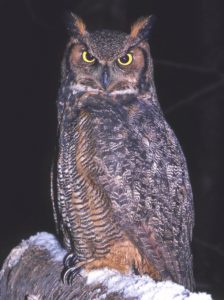Photography courtesy of Lowell Washburn, all rights reserved.
It’s no secret that most Iowans have had enough of winter snow — have had enough of winter cold. But spring is on its way. For one resident bird species, the season has already arrived. From the remote reaches of Iowa forestlands to tiny farm grove woodlots, female great horned owls are already sitting on their nests; patiently warming this year’s clutch of eggs.
Horned owls are the very first bird species to begin nesting in Iowa each year. Serious courtship begins as early as late November. By mid-December, winter woodlands resound with the resonate nighttime hooting of territorial pairs. The males put on the most impressive show which, in addition to boisterous nocturnal caterwaulings, includes animated displays of bill clicking, dancing, bowing, and nonstop offerings of food to the female.
Although the owls’ moonlight serenading can still be heard, the initial frenzy is winding down as pairs get down to the serious business of rearing a family. The female horned owl is a tough and dedicated mother. While sitting atop her clutch of two or three eggs, the brooding female will endure a solid month of ice, sub-zero wind chills, and may even become buried in several inches of heavy, late season snow. But regardless of how severe the weather becomes, the female doesn’t budge. Leaving the nest would quickly doom the eggs.
For at least the next two months, the male will serve as a complete life support system for his nest bound mate and newly hatched chicks. Commonly referred to as Flying Tigers; great horned males are fierce and efficient hunters. Few predators — winged or otherwise — can match the pure unbridled savagery of the horned owl who has failed to punch his meal ticket. Although rodents and cottontails provide standard fare, owls will tackle virtually anything that flies, hops, or crawls. More exotic menu items include crows, other raptors, farm cats — even striped skunks. Although I have never found skunk hide or fur at a nest site, I have handled horned owls that still reeked with the skunk’s unmistakable odor. In spite of the fact that annual supplies of prey items will never be lower than at winter’s end, horned owl families rarely — if ever — miss a meal. I can only assume that a freshly killed skunk must taste a whole lot better than it smells.


 Susan Judkins Josten
Susan Judkins Josten Rudi Roeslein
Rudi Roeslein Elyssa McFarland
Elyssa McFarland Mark Langgin
Mark Langgin Adam Janke
Adam Janke Joe Henry
Joe Henry Sue Wilkinson
Sue Wilkinson Tom Cope
Tom Cope Kristin Ashenbrenner
Kristin Ashenbrenner Joe Wilkinson
Joe Wilkinson Dr. Tammy Mildenstein
Dr. Tammy Mildenstein Sean McMahon
Sean McMahon